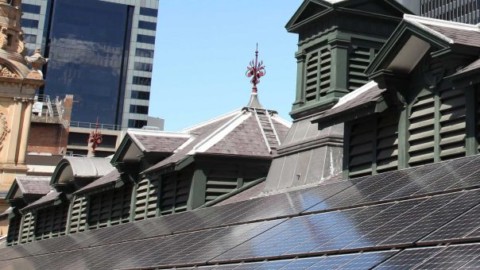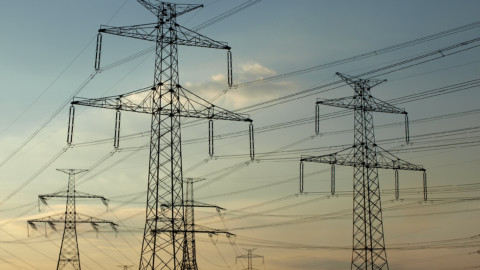Much has been said about energy retailers and their relationship with customers in the past twelve months. Amy Childs, Managing Director of Momentum Energy, is the first person to put her hand up and acknowledge that the relationship needs to change, and Energy Editor Laura Harvey caught up with her to learn more about what she is doing to improve the way customers see their energy retailers.

Since taking on the Managing Director role in an acting capacity in May last year, and permanently from October, Amy Childs has been focused on bringing in a suite of changes that she envisions will both grow the customers that Momentum serves; but also help bring about a more transparent and open approach to energy retailing in Australia.
The first, and most obvious thing, you notice about the way Amy is leading Momentum Energy is where she sits in her office. Amy and her leadership team have done away with offices, and they’re firmly ensconced on the floor, with their staff.
It’s about being open, available, and most importantly, transparent – so it’s no surprise that these are the core values that Amy is aiming to re-establish in the relationship between Momentum and its customers.
Changing the face of energy
Amy is passionate about the energy industry, and passionate about the change she wants to see in the industry.
Prior to taking on the Managing Director role, Amy was Momentum’s General Manager for Sales and Marketing, bringing her total time in the business to three years. According to Amy, in that time, she has interviewed 150 candidates for different roles across the business.
“We’ve really changed the profile of the people that work here in senior roles that are able to influence outcomes that are different,” said Amy.
Amy strongly believes that we can’t keep replicating the same thing in the energy industry – if we do, nothing will change. While of course many staff in the business do have an energy background, she’s not afraid to recruit from outside the industry for key roles, largely in order to put a different lens on the way things are done at Momentum.
“I’ve taken a little bit of a risk, to be honest. I’ve got people that haven’t got energy background experience, and that makes you sometimes feel a bit vulnerable because you might miss something. But I think it’s more important to have people who are passionate about doing the right thing for the customer, and thinking about being part of the energy industry and changing the way it is, with the right mindset.
“I’m passionate about this,” said Amy. “There’s so much opportunity to do well, and I am personally really focused on driving change in the energy industry.
“It’s going to take time, and I have to manage my energy and my expectations, but I believe we will get there.”
Growing an emerging energy retailer
Amy believes that being at the helm of a tier two retail business puts her in the perfect position to help bring about change in the energy industry – the size of the business offers a real competitive advantage when it comes to being agile and able to moveswiftly to make changes that are required.
But of course there are challenges that come with being a tier two operator as well, and according to Amy, probably chief among these is managing churn – when you’re running a business where you’ve already convinced customers to make the switch and move over to you, how do you actually convince them to stay?
“It’s really hard, and we have not cracked this one yet,” admits Amy. “The challenging thing about being a tier two player is we’ve actually encouraged a churner to join us.
“So what we find is that there’s incumbent retailers who have obviously got a large base that can’t be churned, or they don’t know how to. Whereas for us, all of our customers have actually chosen us, so they know what to do. They know how to go and find a good deal. If we don’t live up to their expectations, they’re out of here – and frankly, so they should be.”
Churn is a topic that Amy has clearly spent a lot of time thinking about, and she’s come to several conclusions on the subject – one of these being that when it comes to churn, it’s all on retailers.
Amy believes it ultimately comes back to making the energy supply experience better for customers, and figuring out what can make the interaction between customer and retailer better, so “that you don’t end up leaving us for $30 or $50 a year”.
“It comes down to if you call us, you want to get served quickly. You want to get your issue resolved, and then you just want to be left alone. You actually don’t want to think about your energy too much as a customer,” said Amy.
As well as swift interactions with the business, Amy also believes that providing customers with new services – such as educating them about how they can reduce energy consumption – are key.
“I spend a lot of time thinking about the things we can bring into market that are useful, that customers are willing to pay for? That’s going to help them reduce their energy bills? That’s ultimately what they want, and that will then endear trust which will make them stay longer, which will reduce churn, and then all of a sudden we’re in a place which is much better than we are today.”
Also important to Momentum is their Australian-based call centre, which according to Amy, is something customers really respond to.
“Our customers are calling us because they’re confused, or something has gone wrong. So being able to speak to someone here in Australia, who can understand, empathise, be human in the interaction – I think that’s the magic, that’s where we’ve all got to strive to get to.”
The next step for Momentum’s call centre team is to achieve single call resolution, which means customers only need to call Momentum once to have their query or energy addressed.
“We’re working on that now. We’re trying to avoid the transfer between departments and people that often happens in call centres, and the waiting in queues that can happen.
“Now of course we might not be able to solve everything in the first call, but I want to get to the point where one of our people is saying, ‘I’m Amy, I’ll follow this up for you, and I’ll get back to you on it.’ And you know who that person looking after you is.
Because some things you can’t solve on the first call, it might involve having to call a network or another third party.
“I don’t want to declare victory on that yet, we’re not 100 per cent there, but we are very, very focused on having that done very, very soon.”
Establishing Momentum in a crowded market
In a crowded market like energy retail, businesses like Momentum need to establish a clear voice, and brand identity, to cut through the noise in the marketplace.
Momentum’s repositioning of its business began in 2017 when it “killed the discount” – the company developed a campaign around positioning itself as the 0 per cent discount retailer. But according to Amy, it was a challenge to get everyone in the business on board with this one.
“People worried that customers wouldn’t pay their bills on time without a discount, but it just hasn’t been the case at all,” she said.
After a successful launch for the campaign, and positive reception in the marketplace, a number of other retailers followed Momentum with “no discount” offers. To continue its differentiation in the market, Momentum has just launched a “Less Hassle More Hustle” campaign, in line with the company’s belief that great, no hassle service is the key to retaining and attracting customers.
“Before we launched the Less Hassle More Hustle campaign, we conducted a survey that showed that 94 per cent of Australians find it a hassle dealing with their energy retailer. And while Australians are most concerned about affordable pricing, they also want to see simple rates and good customer service.
“Energy simply isn’t working the way it should be. Somewhere along the line, this industry lost its way and governments felt the need to step in on behalf of customers. But the level of intervention has been so high that it has distracted us from what should be our number one goal – the customer.
“It’s pointless being paralysed by all the change that’s happening in the industry. All we can do is focus on the immediate things we can do to create a better experience for our customers.
“Momentum acknowledges we can do better, particularly in areas such as call centre waiting times. We will use the findings of this survey – and other research – to get busy fixing things for our customers and making sure there is less hassle and more hustle when they’re dealing with us.
“In any marketing we do, we have to cut through. We do not have big pots of money to spend. We need to be really careful how we invest the marketing dollar because ultimately that’s the cost of running the business, which you need to be very mindful of when you’re thinking about customers and their energy prices.”
The next challenge
Looking ahead for Momentum and Amy, the focus for the future will move beyond acquiring and retaining customers, towards some exciting innovations that will change not just the business, but the energy market more broadly as well.
According to Amy, the key upcoming challenge for the sector is working out how retailers play a role in the disruption that’s coming with behind the meter technology.
“We’re on that path now, and we’re working out what our role should be. There’s a lot of case studies out in the market of others who have gone before us, and tried and failed, which is useful – it gives us some intelligence on what worked and what didn’t.
“We’re using that information now to think about how do we play a role, what does that role look like? How do we help customers? That’s where we want to get to, and we’re working on how we put ourselves into a position where we are that trusted provider that is based out of Australia and can help people with what is a really complex and challenging problem.”
At the forefront of these new areas of focus for the business is an ongoing desire to serve as an advocate for energy customers.
“We really want to push for change and disruption, and doing the right thing for customers,” said Amy. “It’s not hard, it’s a choice, and we really want to be leading the charge on that.
“Expect to see more of that from us – more products and propositions that are living up to what we’re trying to do in the market.”

















